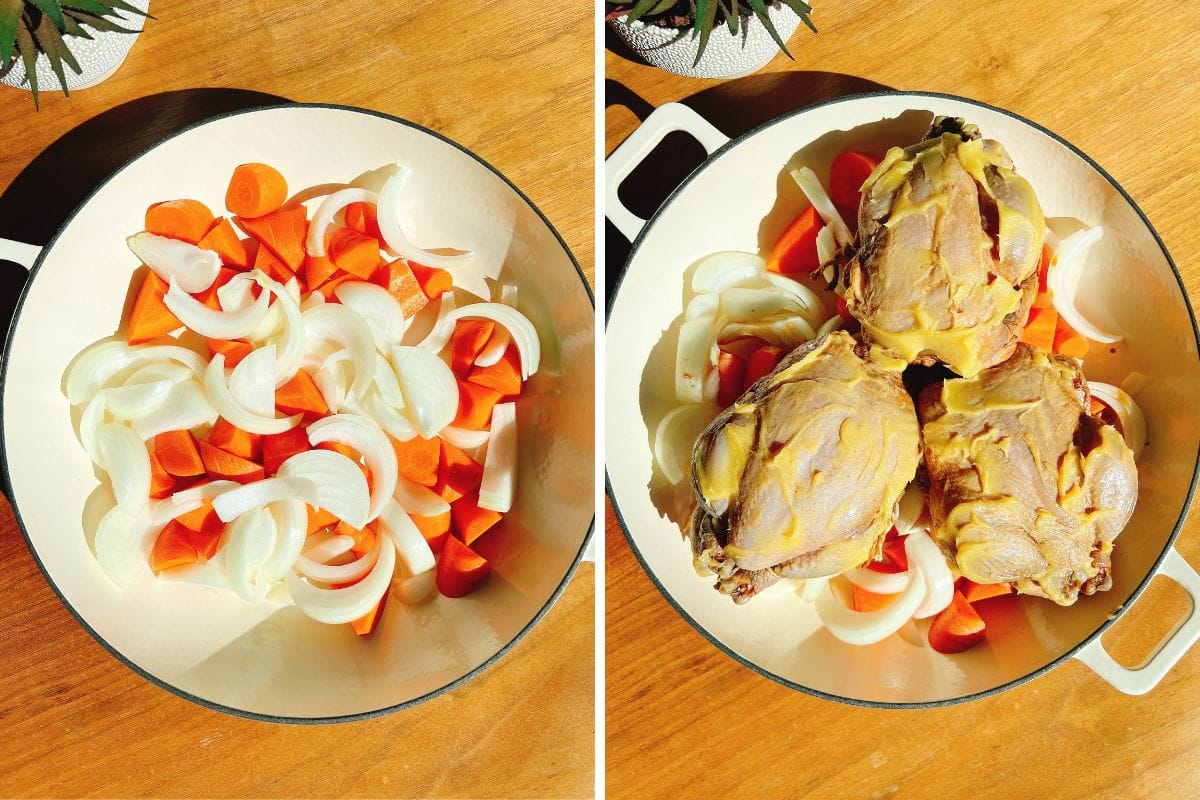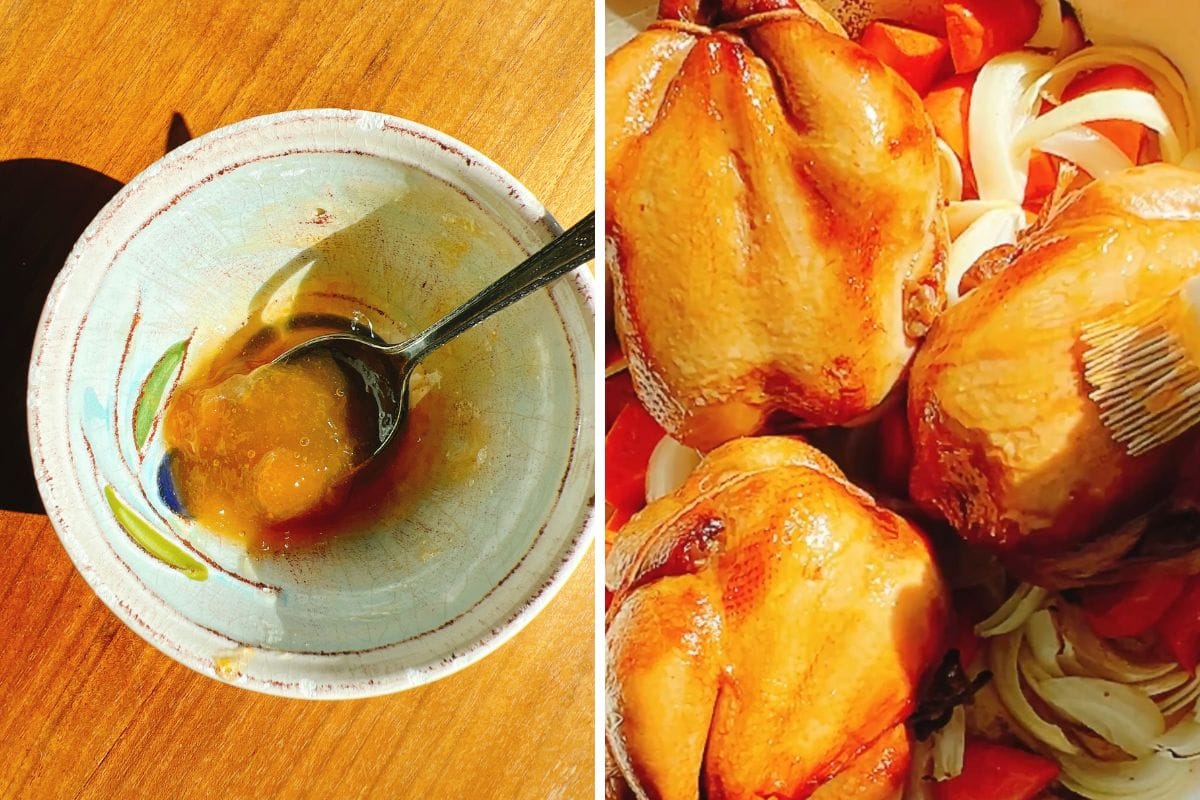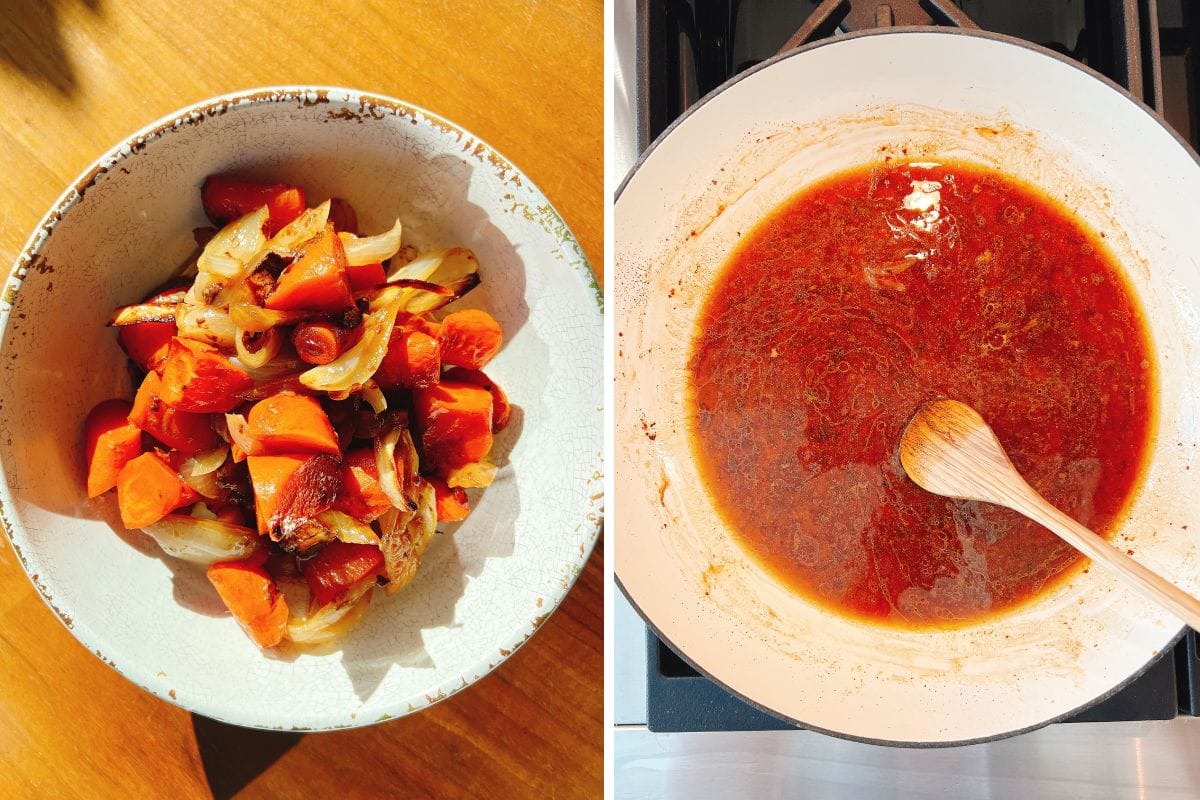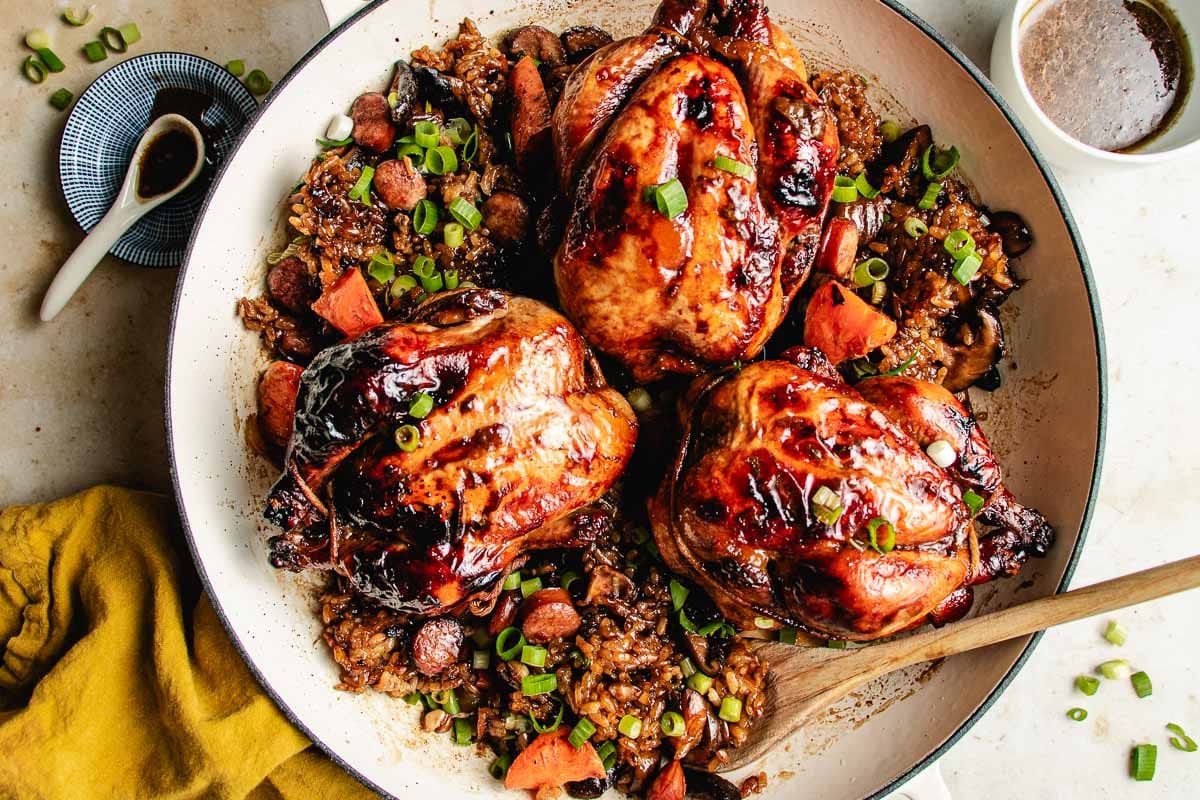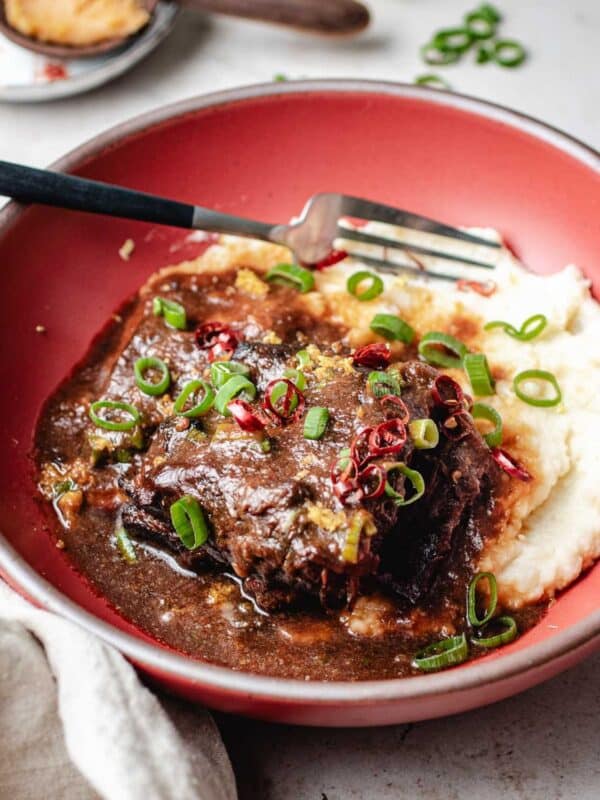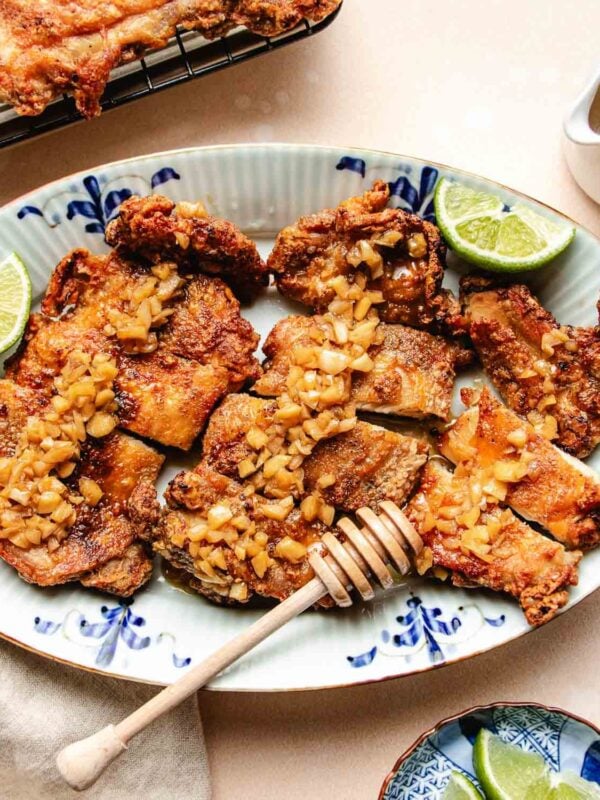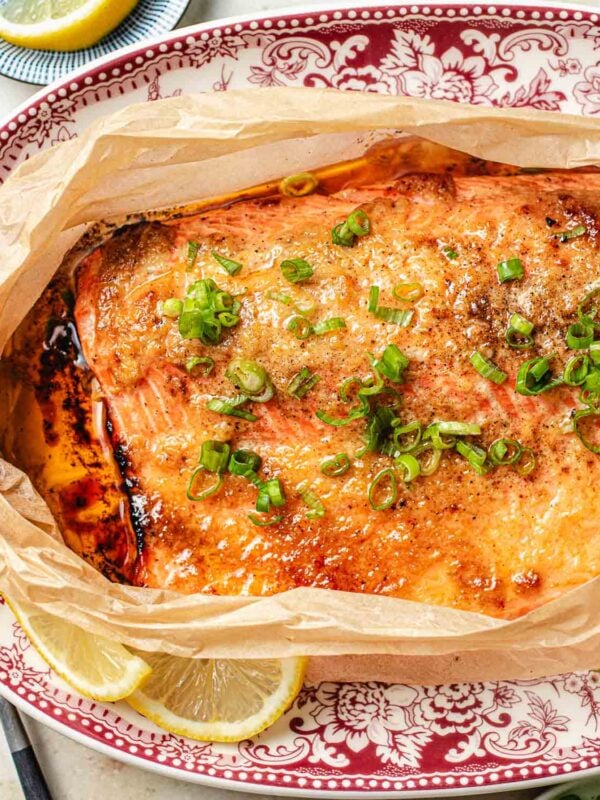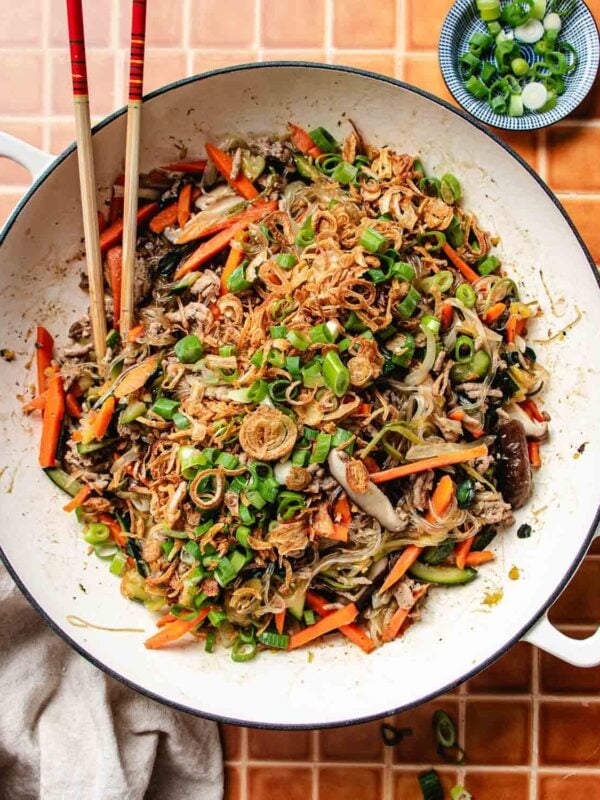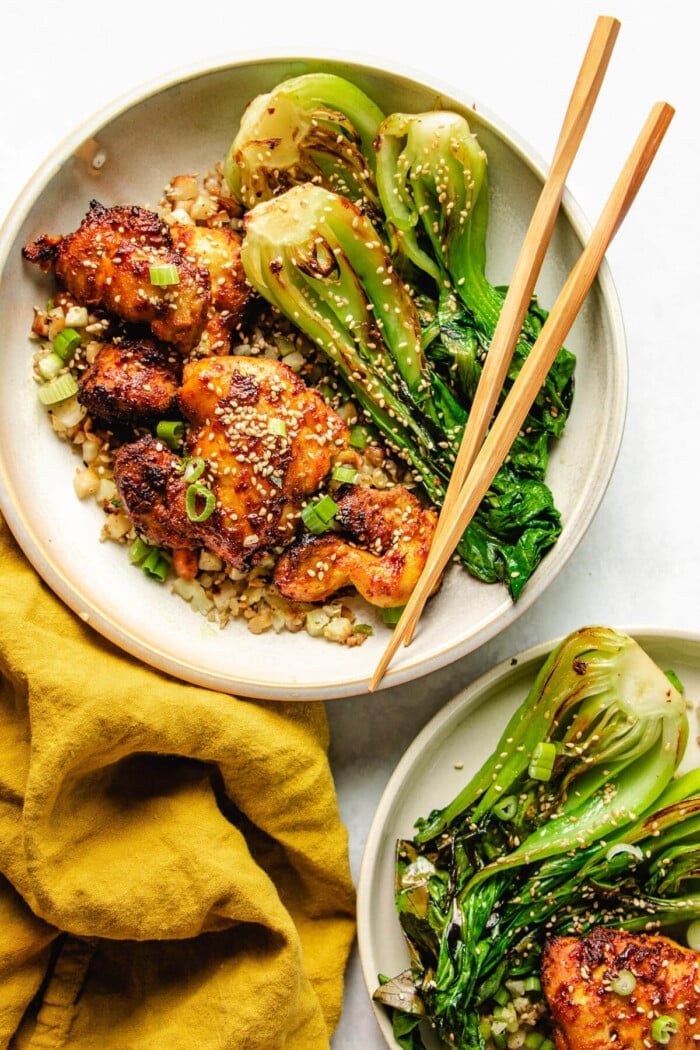This post may contain affiliate links. Please read our disclosure policy.
If you’re looking for a show-stopping holiday main that’s easy to make, these Roasted Cornish Hens are it. Juicy, flavor-packed, and glazed with a Taiwanese-style thick soy sauce, they roast up golden and tender for cozy dinners or small holiday gatherings.
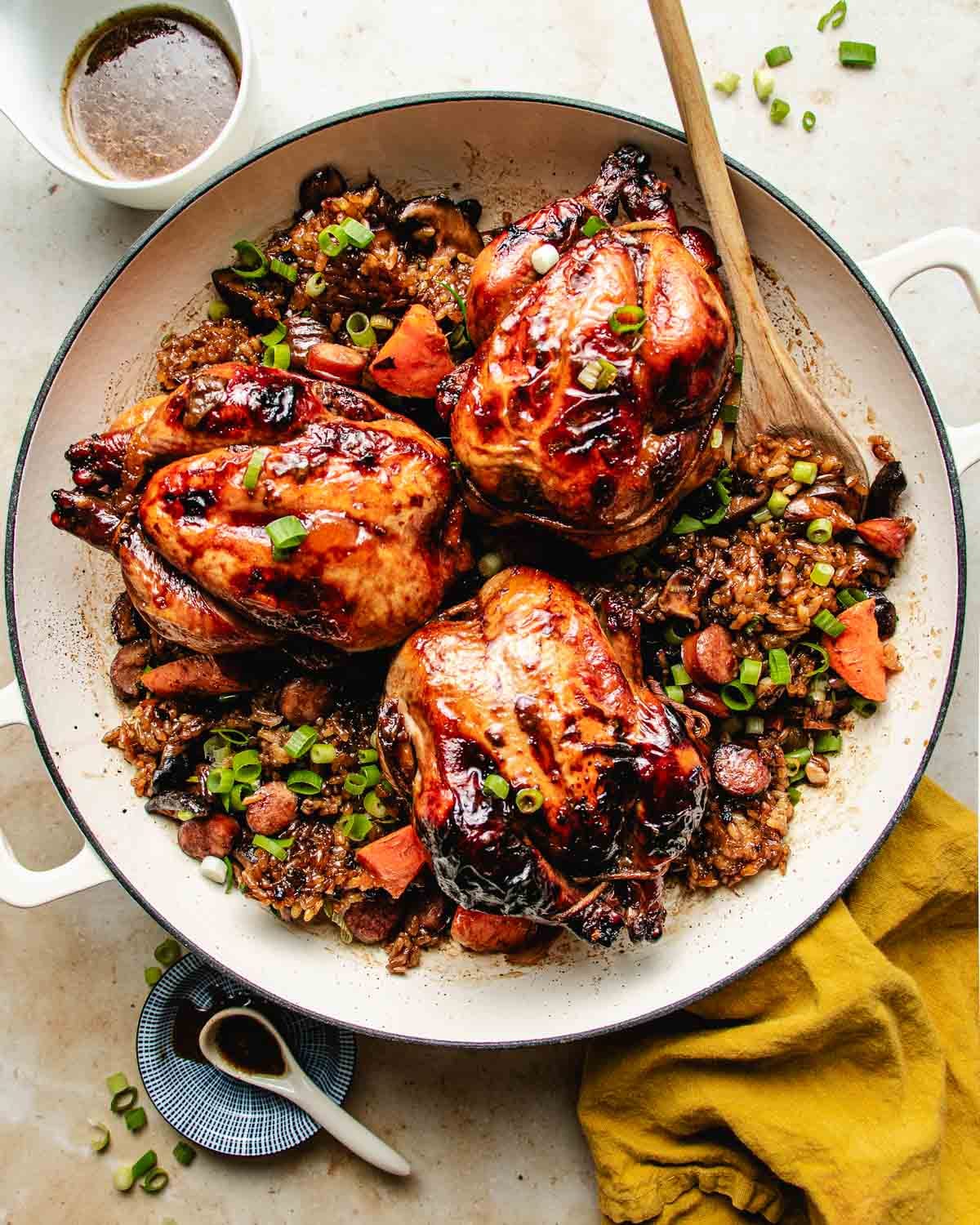
Why this recipe works
This method stays juicy, cooks evenly, and tastes richly savory — without extra fuss. Here’s why:
- Marinated for moisture: The overnight soy glaze keeps the lean meat juicy and flavorful while giving the skin that gorgeous, deep golden color.
- Roasted over vegetables: A shallow pan and sturdy veggies lift the hens so they cook evenly and develop crisp, brown skin all around.
- Perfect timing and temperature: 400°F for about 50 minutes gives beautifully cooked meat — not dry, not underdone.
- Holiday-friendly make-ahead: The hens can be marinated up to 2 days in advance, and the sticky rice stuffing (if using) can be made 3 days ahead. When the big day comes, just roast and serve.
Key Ingredient Notes

- Cornish Game Hens: Cornish hens are small, young chickens that usually weigh about 1 to 1¼ pounds (450–570 g) each. Their tender meat and smaller size make them perfect for individual servings or a small holiday dinner. You can also use frozen hens — just thaw them completely in the fridge for two full days before marinating. If you can’t find Cornish hens, a small poussin or a young chicken works too — just make sure it’s much smaller than a regular bird so the cooking time stays similar.
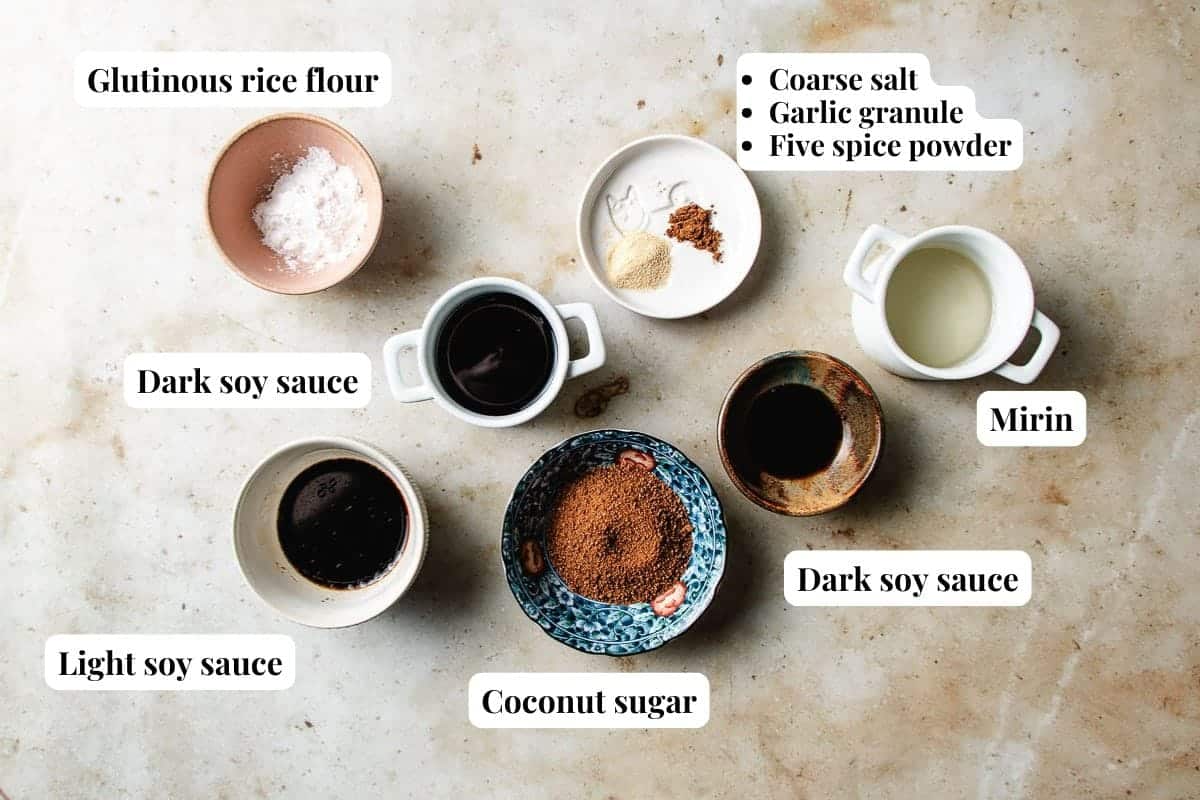
- Taiwanese Thick Soy Sauce (the marinade): This sweet-salty soy glaze is a staple in Taiwanese cooking and often used in place of oyster sauce. It has a warming flavor with hints of licorice and cinnamon that pair beautifully with roasted poultry. My homemade version is made from light and dark soy sauce, mirin, brown sugar, and Chinese black vinegar. It gives the hens a deep golden color and glossy finish while adding rich umami flavor.
- Glutinous Rice Flour (for thickening): Used to thicken the soy glaze so it clings to the chicken and creates a shiny coating. If you don’t have it, tapioca or potato starch will also work in a pinch.
- Butter or Ghee: Brushing a thin layer over the breasts before roasting helps keep the lean meat juicy and adds richness. It also promotes even browning and crisp, golden skin.
- Fruit Jam or Marmalade: A spoonful of jam mixed into the glaze adds light sweetness and a beautiful holiday shine. I like using orange, apricot, peach, or cranberry — all pair perfectly with the soy-based sauce and make the meat extra flavorful and moist.
- Aromatics (Onion and Carrot Base): These sturdy vegetables lift the hens slightly while they roast, so the hot air circulates and the skin stays crisp. They soak up the pan drippings and become extra delicious — you can serve them right alongside the hens.
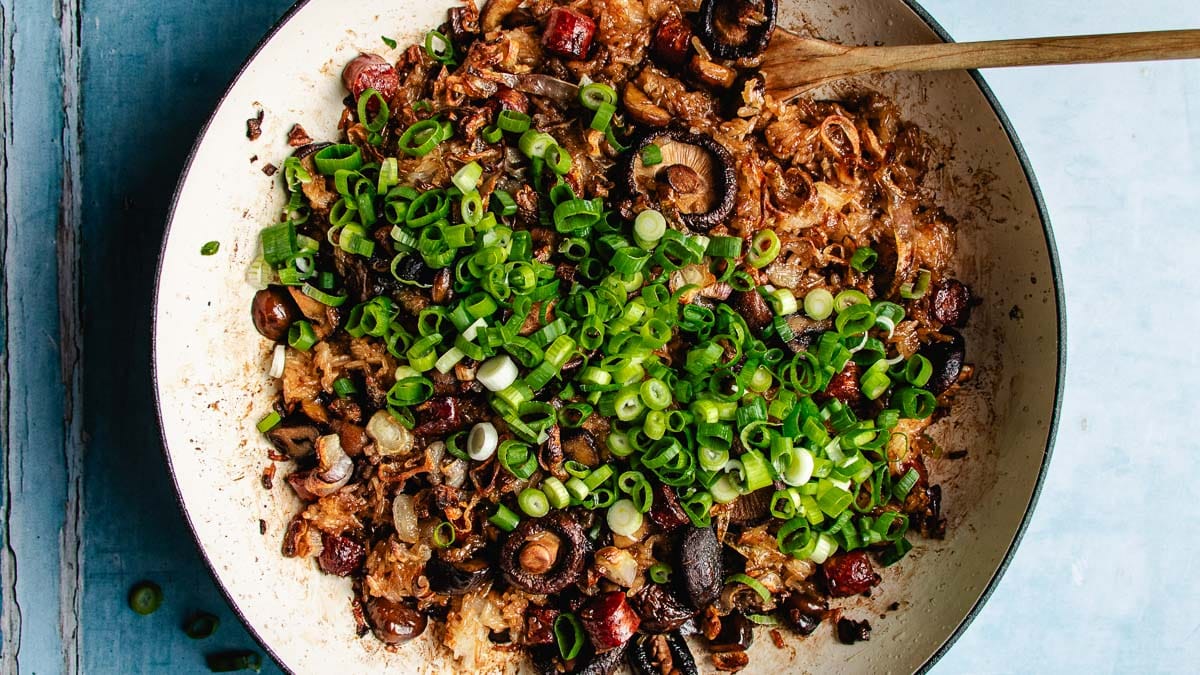
- Sticky Rice Stuffing (Optional): I like serving the hens with a side of Chinese sticky rice stuffing — it’s comforting, flavorful, and pairs beautifully with the savory glaze. You can make it a few days ahead and reheat it before serving. Feel free to use any stuffing you like, or skip it altogether if you prefer.
Cooking tips for the best roasted cornish hens
I tested different stuffing ideas, oven temperatures, and pan setups before landing on this version that stays juicy, evenly cooked, and crisp on the outside. These are the takeaways that finally made the recipe foolproof.
How to Build Flavor and Keep the Meat Juicy
The Taiwanese-style soy glaze makes all the difference. It’s rich, slightly sweet, and full of warmth from five-spice and Chinese black vinegar. The sauce gives the hens deep roasted-duck color and flavor while keeping the lean meat moist.
Marinate overnight (or up to two days ahead) so the flavor goes all the way through. I start breast-side down so the most delicate part gets extra soak time, then flip them in the morning. By the time you roast, the meat is seasoned, juicy, and beautifully bronzed.
About the Pan and Vegetables
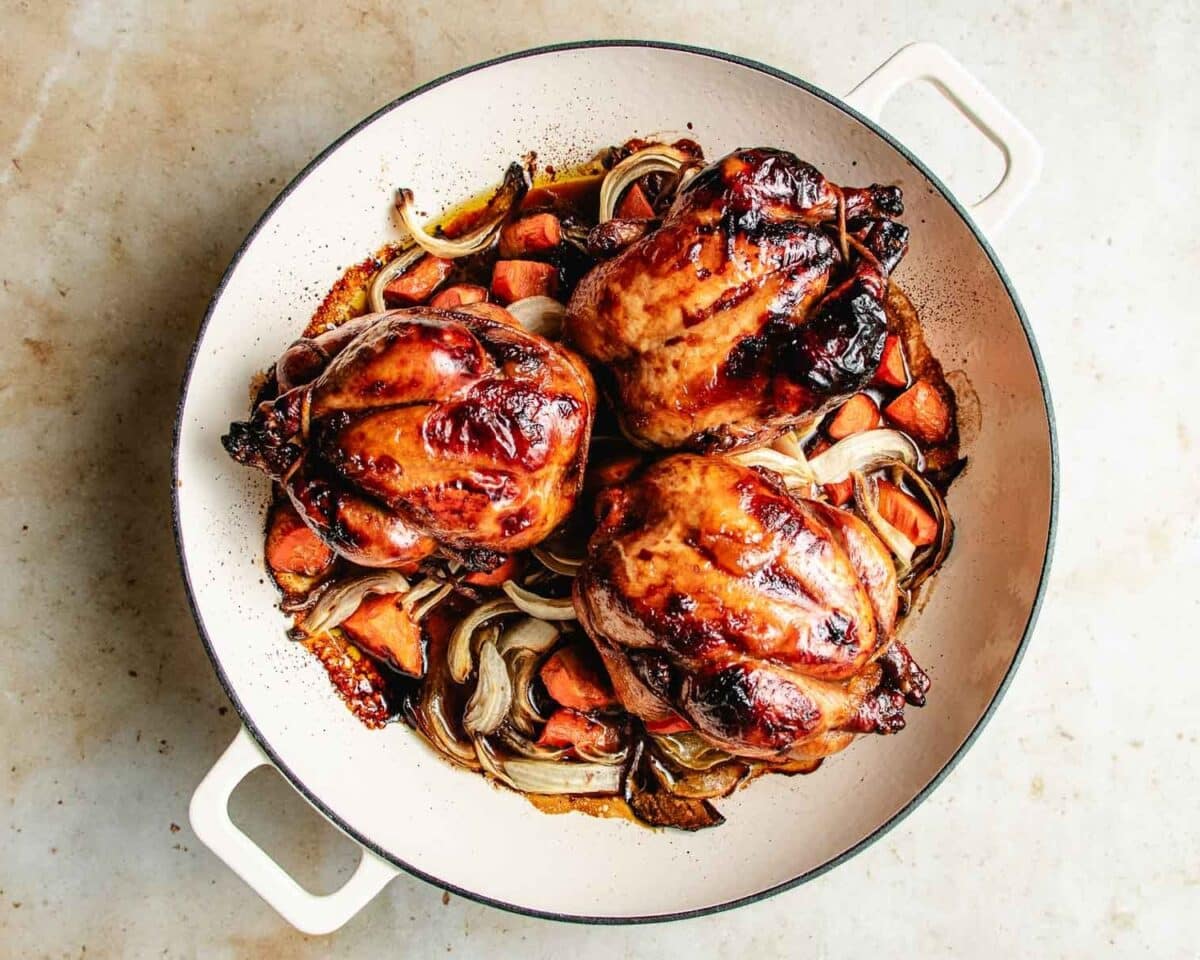
I tried using a roasting rack at first, but honestly, it wasn’t worth the cleanup — and the bottom of the hens missed out on flavor. Roasting them right on a bed of sturdy vegetables works much better. Carrots and onions lift the birds for airflow so the skin crisps, while also soaking up all the pan drippings and turning sweet and caramelized.
Avoid watery vegetables like zucchini or mushrooms; they release too much moisture and make the bottoms soft. And give the birds space — I use a 14-inch shallow cast-iron paella pan (or a Dutch oven braiser) and can fit three hens comfortably. Four gets too tight, and crowded hens steam instead of brown.
Roasting Time and Temperature
When I first tested recipes online, many called for only 30 to 35 minutes, but my hens came out underdone — the thermometer barely reached 130°F. After several trials, I found that 400°F (200°C) for about 50 minutes is the sweet spot for birds around 1 to 1¼ pounds.
If yours are larger, add about 10 minutes for every extra ¼ pound. Around the 30-minute mark, baste the hens with the pan juices and brush on a bit of glaze. It adds shine, keeps the meat moist, and deepens that golden color. If the tops brown too quickly, loosely cover those spots with foil “jackets.”
That combination — marinating overnight, roasting on vegetables, and basting halfway through — finally gave me Cornish hens that come out evenly cooked, golden brown, and tender from edge to center.
How to Check When Cornish Hens Are Done

It took me a few rounds to figure this out. Because the birds are so small, it’s easy to push the thermometer too far and hit the cavity, which gives a false low reading.
Insert a digital meat thermometer into the thickest part of the thigh where the leg meets the body — stop once you’re in the center of the meat, not the hollow inside. You’re aiming for 165°F (74°C). Once it hits that, remove the hens and let them rest for about 15 minutes so the juices redistribute.
No thermometer? Use Jacques Pépin’s classic trick: make a small slice between the thigh and breast. If the juices run clear, the hens are ready.
What to serve with cornish game hens
These Cornish hens make such a cozy centerpiece for a small holiday table or an elegant weekend dinner. I love serving them with a few easy vegetable sides and creamy comfort dishes that balance the savory soy glaze.
- Vegetable sides: Try pairing the hens with Roasted Carrots and Beets or Asian Brussels Sprouts for a pop of color and freshness. For something heartier, Roasted Red Kuri Squash or Roasted Cauliflower add sweetness and a nutty depth that go beautifully with the glaze.
- Instead of stuffing: If you’d rather skip the sticky rice stuffing, serve the hens with Miso Mashed Sweet Potatoes or Cauliflower Mashed Potatoes. Both are creamy, rich, and make a perfect base for spooning over the pan jus.
Leftover ideas
- Carcasses: Use to make broth for soups like turkey pho, Chinese chicken soup, or hot pot broth. Store up to 3 days in the fridge or 3 months in the freezer.
- Shredded meat: Great in Asian chicken noodle soup, chicken corn egg drop soup, or chicken kale soup. Use within 3 days or freeze for up to 1 month.
FAQs
Yes, you can! Just thaw them completely in the fridge for two full days before marinating. This gives the meat time to defrost evenly so it roasts properly and stays juicy.
They’re tiny birds, so they cook faster than regular chicken. The best way to keep them juicy is to marinate overnight, brush with butter before roasting, and baste halfway through. Cover any fast-browning spots with foil if needed.
I don’t recommend it. Because Cornish hens are small and lean, the stuffing takes longer to cook than the meat, which often leaves the hens overdone. It’s much safer (and easier) to serve the stuffing on the side.
Use a wide, shallow pan — not a deep turkey roaster. High pan walls trap moisture and prevent good air circulation, which keeps the skin from crisping up. A shallow pan (like a paella, Dutch oven braiser, or low-sided roasting pan) lets the heat circulate evenly so the skin turns golden and crisp. Also, don’t overcrowd the birds, and use sturdy vegetables underneath to lift them up and keep the bottoms from steaming.
Use a digital meat thermometer and check the thickest part of the thigh (where the leg meets the body). It should read 165°F (74°C). Be careful not to poke into the cavity — it’s air inside, and that will read cooler than the actual meat.
More cornish hen recipes you might like
If you enjoyed this roasted version, try a few of my other Cornish hen recipes next time — each one has its own flavor twist but stays just as cozy and easy to make.
- Air Fryer Cornish Hens: A faster, hands-off option that gives you crisp skin and tender meat in under an hour. (coming soon)
- Cornish Hen Soup: An Asian-style soup simmered with carrots, daikon, shiitake, and ginseng — light, nourishing, and perfect for colder days. (coming soon)

Roasted cornish hens recipe with sticky rice stuffing
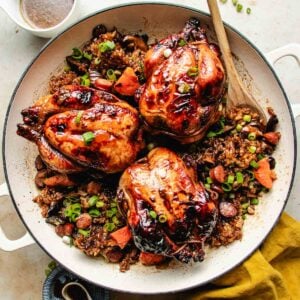
Ingredients
Taiwanese Thick Soy Sauce (for marinating):
- 6 tbsp light soy sauce
- 6 tbsp dark soy sauce
- ½ cup water (120 ml )
- 4 tbsp mirin
- 6 tbsp coconut brown sugar
- 4 tsp Chinese black vinegar
- ¼ tsp garlic granules
- ¼ tsp coarse sea salt
- 2 small pinch five-spice powder
- 2 tbsp glutinous rice flour for slurry — see notes for alternatives
For the Cornish Hens:
- 3-4 Cornish hens 1–1.25 lb / 450–570 g each
- 1 large yellow onion about 11 oz / 310 g
- 2 large carrots about 13 oz / 370 g
- 3-4 tbsp ghee or softened butter about 1 tbsp per bird
- 2-3 tbsp orange, apricot, peach, or cranberry jam or marmalade
- ¼ cup chicken broth or stock 60 ml (add more if the pan has little juice)
Optional serving:
- Sticky rice stuffing serve on the side
Equipment
- 1 14-inch wide or larger Dutch oven braiser/skillet (fits 3–4 hens with some space between)
- Twine (for trussing)
- Foil
Instructions
Before You Start:
- Plan ahead — this recipe includes an overnight marinade to give the hens their deep flavor. Make the sauce and let the hens marinate in the fridge overnight before roasting the next day.
- If you’re serving the hens with sticky rice stuffing, you can make it the same day, but I recommend preparing it ahead for a stress-free holiday. (See the recipe notes below for details.)
Make the sauce marinade:
- In a saucepan, combine light soy sauce, dark soy sauce, water, mirin, sugar, vinegar, garlic granules, salt, and five-spice powder. Bring to a gentle simmer over medium-low heat, stirring to dissolve the sugar (about 5–6 minutes). In a small bowl, mix glutinous rice flour with 4 tbsp water to make a smooth slurry, then whisk it into the sauce. Stir constantly until the sauce thickens slightly — it should be just thinner than maple syrup (about 2 minutes). Remove from heat and let cool; it will thicken a bit more as it cools.
- If using tapioca starch, simmer for only 30 seconds. The sauce may look thick and gloopy at first — it will loosen overnight in the fridge. Please see more info in the recipe notes section below.
Marinate the hens:
- Pat the hens dry and trim the wing tips for better presentation. Transfer the hens to containers, breast side down, and coat them all over (including the cavity) with about 5 tbsp of thick soy sauce per bird. Marinate overnight in the fridge, then flip them breast side up in the morning.
Prepare the vegetables:
- Cut the carrots into chunks and slice the onion into wedges. These will help prop up the birds during roasting. Set aside.
Prepare the hens for roasting:
- After marinating, let the excess marinade drip off before baking. Reserve the leftover marinade to use later as a brushing sauce. Truss the hens, then brush each bird with ghee or softened butter on the side facing up.
Roast:
- Preheat the oven to 400°F (200°C). Drizzle the roasting pan with olive oil, add the carrots and onions, and place the hens breast side up on top of the vegetables. Roast on the middle rack for 45–50 minutes total.
Baste with Fat and Glaze with Sweet Jam:
- After 30 minutes, remove the pan and baste the hens with the pan juices (mainly the rendered fat). For the sweet glaze, mix a spoonful of marmalade or jam with a splash of water and brush it over the breasts. Return the pan to the oven for another 15–20 minutes, basting every 10 minutes.
- Check frequently — if the skin browns too quickly, loosely cover those areas with foil. The internal temperature should reach 165°F (74°C) at the thickest part of the thigh (without touching the bone). Let rest for 15 minutes before serving.
Sticky rice stuffing:
- If serving with sticky rice, warm it in the microwave with a splash of water. Keep it covered and warm so the rice stays soft and chewy.
Make the pan jus:
- Transfer the hens and vegetables to a platter and cover with foil to keep warm. Add chicken stock to the roasting pan and scrape up the browned bits with a wooden spoon. Simmer briefly until the bits dissolve and the liquid reduces slightly. Pour into a serving bowl or gravy boat.
Serve:
- Transfer the roasted carrots and onions to a large serving platter and place the hens on top. Spoon the sticky rice stuffing around the birds so guests can easily serve themselves. Garnish with sliced scallions and serve hot with the pan jus on the side.
Notes
- Safe temperature: Cornish hens are done at 165°F (74°C). Insert the thermometer into the thickest part of the thigh without touching the bone or going into the cavity. Another way to check doneness is by slicing between the thigh and breast — if the juices run clear, the meat is cooked through.
- Glutinous rice flour (and substitutes):
- Glutinous rice flour gives the sauce a glossy, slightly sticky texture that thickens without turning gloopy. It also helps the sauce maintain its consistency after refrigeration without becoming watery.
- In a pinch, you can use tapioca or potato starch. They behave a bit differently from glutinous rice flour but still help thicken the sauce. Cook for no more than 30 seconds — otherwise, the sauce will become overly thick and gluey. The texture will be a little denser and less elastic, but it won’t affect the flavor when used as a quick substitute.
- Why I serve stuffing on the side: After extensive testing, I found that stuffing small birds like Cornish hens causes uneven cooking. By the time the stuffing reaches a safe internal temperature, the meat is overcooked. For food safety (as the FDA advises) and better texture, I recommend serving sticky rice stuffing on the side.
- Make-ahead:
- Chicken: Marinate up to 2 days in advance, rotating occasionally so all sides stay coated.
- Thick soy sauce: Prepare 4–5 days ahead and store in the fridge.
- Sticky rice stuffing: Make up to 3 days in advance. Reheat in the microwave on medium power, loosely covered, until warmed through. Keep it warm to maintain its soft, sticky texture — once cooled, it becomes dry and firm.
- How to truss a whole chicken – Jacques Pépin Techniques: How To Truss a Chicken for Roasting
Nutrition
Nutrition information is automatically calculated, so should only be used as an approximation.
Made a dish and loved it? Please rate the recipe and leave a comment in the section below! It helps my blog grow organically, allowing me to continue sharing free and awesome content with you. Thank you!


